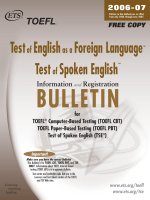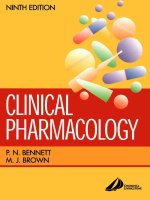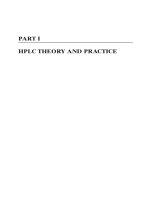Ultrasound for Surgeons - part 1 doc
Bạn đang xem bản rút gọn của tài liệu. Xem và tải ngay bản đầy đủ của tài liệu tại đây (476.85 KB, 19 trang )
m
V
m
Ultrasound
for Surgeons
Heidi L. Frankel
a d e m e c u
LANDES
BIOSCIENCE
Ultrasound for Surgeons
Frankel
ad eme cum
V
V
a d e
m
e c u
Table of contents
1. Education Credentialing
and Getting Started:
With Attention to Physics
and Instrumentation
2. FAST (Focused
Assessment by
Sonography in Trauma)
3. Chest Trauma
4. Abdominal Aortic
Aneurysm Screening
in the Emergent Setting
5. Appendicitis
6. Pediatric Applications
7. Surveillance of Deep Vein
Thrombosis (DVT)
The Vademecum series includes subjects generally not covered in other handbook
series, especially many technology-driven topics that reflect the increasing
influence of technology in clinical medicine.
The name chosen for this comprehensive medical handbook series is Vademecum,
a Latin word that roughly means “to carry along”. In the Middle Ages, traveling
clerics carried pocket-sized books, excerpts of the carefully transcribed canons,
known as Vademecum. In the 19th century a medical publisher in Germany, Samuel
Karger, called a series of portable medical books Vademecum.
The Landes Bioscience Vademecum books are intended to be used both in the
training of physicians and the care of patients, by medical students, medical house
staff and practicing physicians. We hope you will find them a valuable resource.
All titles available at
www.landesbioscience.com
8. Insertion of the Central
Catheters
9. Transcranial Doppler
10. Diagnosis and Treatment
of Fluid Collections
and Other Pathology
11. Open Applications
12. Laparoscopic Applications
13. Breast Ultrasound
14. Vascular
15. Rectal
LANDES
BIOSCIENCE
ISBN 1-57059-597-6
9 781570 595974
Heidi L. Frankel, M.D., F.A.C.S.
Associate Professor of Surgery
Section of Trauma and Surgical Critical Care
Yale University
New Haven, Connecticut, U.S.A.
Ultrasound for Surgeons
G
EORGETOWN
, T
EXAS
U.S.A.
vademecum
L A N D E S
B I O S C I E N C E
VADEMECUM
Ultrasound for Surgeons
LANDES BIOSCIENCE
Georgetown, Texas U.S.A.
Copyright ©2005 Landes Bioscience
All rights reserved.
No part of this book may be reproduced or transmitted in any form or by any
means, electronic or mechanical, including photocopy, recording, or any
information storage and retrieval system, without permission in writing from the
publisher.
Printed in the U.S.A.
Please address all inquiries to the Publisher:
Landes Bioscience, 810 S. Church Street, Georgetown, Texas, U.S.A. 78626
Phone: 512/ 863 7762; FAX: 512/ 863 0081
ISBN: 1-57059-597-6
Library of Congress Cataloging-in-Publication Data
While the authors, editors, sponsor and publisher believe that drug selection and dosage and
the specifications and usage of equipment and devices, as set forth in this book, are in accord
with current recommendations and practice at the time of publication, they make no
warranty, expressed or implied, with respect to material described in this book. In view of the
ongoing research, equipment development, changes in governmental regulations and the
rapid accumulation of information relating to the biomedical sciences, the reader is urged to
carefully review and evaluate the information provided herein.
Frankel, Heidi L.
Ultrasound for surgeons / Heidi L. Frankel.
p. ; cm. (Vademecum)
Includes index.
ISBN 1-57059-597-6
1. Ultrasonics in surgery. 2. Operative ultrasonography. I. Title.
II. Series.
[DNLM: 1. Ultrasonography methods Handbooks. 2. Surgical
Procedures, Operative methods Handbooks. WN 208 F828u 2004]
RD33.7.F73 2004
617'.07543 dc22
2003025277
Dedication
Dedicated to my husband, John,
and spouses like him, who allow us to practice our craft.
Contents
Foreword 12
Acknowledgements 14
1. Education Credentialing and Getting Started:
With Attention to Physics and Instrumentation 1
Vicente H. Gracias, Heidi Frankel and Ronald I. Gross
Historical Perspective 1
Education in Surgeon-Performed Ultrasound: Training/Credentialing
and Practice Domains 1
Credentialing in Ultrasound 2
A Physics Primer 6
Appendix I. CESTE Guidelines Surgeon Eligibility
and Verification in Basic Ultrasonography 7
Appendix II. Credentialing Requirements for Granting of Privileges
to Surgeons to Perform the Focused Abdominal Sonogram
in Reply To: Trauma (FAST) 9
General Principles 9
Training 9
Maintenance of Qualifications 10
Use in the Emergent Setting
2. FAST (Focused Assessment by Sonography in Trauma) 11
Ronald I. Gross
History 12
Technique: Performing the FAST Examination 14
Advantages and Drawbacks of the FAST Examination 19
Application: Uses of FAST in the Acute Setting 21
Future Applications of Ultrasound in the Acute Setting 24
Appendix I. Lectures for Postgraduate Course No. 23: Ultrasound
for the General Surgeon 26
3. Chest Trauma 30
Frank Davis and M. Gage Ochsner
Cardiac Injuries 30
Blunt Cardiac Injuries 34
Traumatic Effusions (Hemothoraces) 35
Ultrasound Diagnosis of Pneumothorax 37
TEE 39
IVUS Assessment of Traumatic Injury to the Thoracic Aorta 44
4. Abdominal Aortic Aneurysm Screening
in the Emergent Setting 49
David B. Pilcher
Relation of Aneurysm Size to Risk of Rupture 49
Ultrasound Equipment 49
Information by Ultrasound Other Than Aneurysm Presence and Size 52
Performing Aortic Aneurysm Ultrasound 52
Comparison to CT Scan and Plain X-Rays 52
5. Appendicitis 54
Shyr-Chyr Chen
Historical Review 54
Graded Compression Technique 55
Modified Compression Method 57
Sonography of Normal Appendix 60
Sonographic Diagnosis of Appendicitis 61
6. Pediatric Applications 68
Oluyinka Olutoye, Richard Bellah and Perry Stafford
Acute Appendicitis 68
Hypertrophic Pyloric Stenosis (HPS) 70
Intussusception 72
Intestinal Malrotation 73
Testicular Torsion 73
Trauma 76
Use in the ICU
7. Surveillance of Deep Vein Thrombosis (DVT) 78
Rajan Gupta and Jeffrey Carpenter
History and Indications 78
Technique and Pitfalls 80
8. Insertion of Central Catheters 84
Ta r ek Razek and Michael Russell
Background 84
The Problem 84
Guided Techniques 85
Potential Disadvantages to the Routine Use of Ultrasound Guidance 87
Clinical Efficacy of Ultrasound Guided Central Venous Cannulation 87
9. Transcranial Doppler 91
George Counelis and Grant Sinson
Technique 91
Clinical Usage 92
Cerebrovascular Disease 94
Aneurysmal Subarachnoid Hemorrhage 96
Occlusive Disease 97
Arteriovenous Malformations 98
Traumatic Brain Injury 98
Intracranial Pressure and Brain Death 99
10. Diagnosis and Treatment of Fluid Collections
and Other Pathology 102
Mark McKenney and Morad Hameed
Technical Considerations 102
Specific Applications—Indications, Methods, and Limitations 104
Placement of Suprapubic Catheters 109
Use in the Operation Room
11. Open Applications 111
Paul V. Gallagher, David Wherry and Richard Charnley
General Indications for Intraoperative Ultrasound 111
Ultrasound Equipment for IOUS and LUS 112
The Scope of Operative Ultrasound 113
Intraoperative Ultrasound of the Liver 114
Intraoperative Ultrasound of the Pancreas 122
IOUS and LUS during Cholecystectomy 125
Other Indications of Intraoperative Ultrasound 125
12. Laparoscopic Applications 128
Raj R. Gandhi
Indications for Use of LUS 128
Instruments 128
Techniques 130
LUS: Specific Techniques and Applications 130
Use in the Office / Preoperative Setting
13. Breast Ultrasound 133
Sheryl Gabram and Nicos Labropoulos
Biopsy Types 133
Training and Credentialing 135
Equipment and Technique 136
Ultrasound Classification of Lesions 138
Ultrasound Biopsy Technique 140
14. Vascular 142
David Neschis and Jeffrey Carpenter
General Concepts Used in Evaluating the Vasculature
with Doppler Ultrasound 145
Effects of Stenoses 147
Specific Indications for Use of Duplex Ultrasound
in the Office Setting 148
15. Rectal 155
John Winston and Lee E. Smith
Indications 155
Preparation and Technique 156
Anatomy 157
Staging of Carcinomas 161
Sphincter Injuries 161
Abscesses and Fistulas 163
Follow-Up of Tumors 164
Retrorectal Tumors and Biopsies 165
Biopsies 165
Results, Accuracy, Sensitivity and Specificity 165
Index 169
Editor
Contributors
Heidi L. Frankel
Associate Professor of Surgery
Section of Trauma and Surgical Critical Care
Yale University
New Haven, Connecticut, U.S.A.
Chapter 1
Richard Bellah
Surgical Resident
Children's Hospital of Philadelphia
Philadelphia, Pennsylvania, U.S.A.
Chapter 6
Jeffrey Carpenter
Associate Professor of Surgery
University of Pennsylvania School
of Medicine
Director, Vascular Laboratory
Hospital of the University of Pennsylvania
Philadelphia, Pennsylvania, U.S.A.
Chapters 7, 14
Richard Charnley
Consultant Hepatobiliary and Pancreatic
Surgeon
Hepato-Pancreato-Biliary Surgery Unit
Freeman Hospital
Newcastle upon Tyne, U.K.
Chapter 11
Shyr-Chyr Chen
Vice-Chairman and Associate Professor
Department of Emergency Medicine
National Taiwan University College
of Medicine
Taipai, Taiwan
Chapter 5
George Counelis
Attending Neurosurgeon
Diablo Neurosurgical Medical Group, Inc.
Walnut Creek, California, U.S.A.
Chapter 9
Frank Davis
Assistant Chief Trauma, Surgical
Critical Care
Memorial Health University Medical Center
Associate Professor of Surgery
Mercer School of Medicine
Savannah, Georgia, U.S.A.
Chapter 3
Sheryl Gabram
Director, Breast Care Center
Cardinal Bernardin Cancer Center
Vice Chairman of Education and Program
Director
Associate Professor of Surgery
Loyola University Medical Center
Maywood, Illinois, U.S.A.
Chapter 13
Paul V. Gallagher
Consultant Surgeon
Northumbria Health Care NHS Trust
North Shields, Tyne and Wear, U.K.
Chapter 11
Raj R. Gandhi
Medical Director for Trauma Services
Hillcrest Baptist Medical Center
Waco, Texas, U.S.A.
Chapter 12
Vicente H. Gracias
Assistant Professor of Surgery
University of Pennsylvania Medical Center
Philadelphia, Pennsylvania, U.S.A.
Chapter 1
Ronald I. Gross
Assistant Professor of Traumatology
and Emergency Medicine
University of Connecticut
School of Medicine
Associate Director of Trauma
Hartford Hospital
Hartford, Connecticut, U.S.A.
Chapters 1, 2
Rajan Gupta
Assistant Professor of Surgery
Division of Traumatology and Surgical
Critical Care
University of Pennsylvania School
of Medicine
Philadelphia, Pennsylvania, U.S.A.
Chapter 7
Morad Hameed
Assistant Professor of Surgery
University of British Columbia
Trauma Services, Vancouver General
Hospital
Vancouver, British Columbia, Canada
Chapter 10
Nicos Labropoulos
Assistant Professor of Surgery
Director, Vascular Laboratory
Department of Surgery
Loyola University Medical Center
Maywood, Illinois, U.S.A.
Chapter 13
Mark McKenney
Professor of Surgery
Department of Surgery
University of Miami
Miami, Florida, U.S.A.
Chapter 10
David Neschis
Assistant Professor of Surgery
Division of Vascular Surgery
University of Maryland Medical Center
Baltimore, Maryland, U.S.A.
Chapter 14
M. Gage Ochsner
Professor of Surgery
Mercer University School of Medicine
Savannah, Georgia, U.S.A.
Chapter 3
Oluyinka Olutoye
Surgical Resident
Children's Hospital of Philadelphia
Philadelphia, Pennsylvania, U.S.A.
Chapter 6
David B. Pilcher
Professor of Surgery
Division of Vascular Surgery
University of Vermont
College of Medicine
Burlington, Vermont, U.S.A.
Chapter 4
Tarek Razek
Assistant Professor of Surgery
McGill University Health Center
Montreal General Hospital
Montreal, Quebec, Canada
Chapter 8
Grace S. Rozycki
Department of Surgery
Emory University School of Medicine
Atlanta, Georgia, U.S.A.
Foreword
Michael Russell
Assistant Professor Anesthesia
and Surgical Critical Care
University of Pennsylvania
Director, Anesthesia and
Cardiopulmonary Services
The Outer Banks Hospital
Nags Head, North Carolina, U.S.A.
Chapter 8
Lee E. Smith
Professor of Surgery
Georgetown University
Director, Section of Colon and Rectal
Surgery
Washington Hospital Center
Washington, D.C., U.S.A.
Chapter 15
Perry Stafford
Pediatric Surgeon
Jersey City Medical Center
Jersey City, New Jersey, U.S.A.
Chapter 6
Grant Sinson
Associate Professor of Neurosurgery
Medical College of Wisconsin
Milwaukee, Wisconsin, U.S.A.
Chapter 9
David Wherry
Professor of Surgery
Uniformed Services University
of the Health Sciences
Bethesda, Maryland, U.S.A.
Chapter 11
John Winston
Assistant Professor of Surgery
Ohio State University
Columbus, Ohio, U.S.A.
Chapter 15
Foreword
In recent years, technology has revolutionized the practice of surgery. As
part of this change, surgeon-performed ultrasound has become one of the
most integral parts of the surgeon’s clinical practice. It is not surprising to
observe this current surge of interest in ultrasound by general surgeons be-
cause surgeons are highly motivated to provide the best possible care for
their patients, including the use of the latest technologic advances in diag-
nosis and treatment. Furthermore, ultrasound equipment is compact, af-
fordable and user-friendly so that extensive training is not required to mas-
ter focused ultrasound techniques. Cost containment initiatives by patients,
clinicians and third-party payers have encouraged the use of modalities, such
as ultrasound, that save time and money. Considering the unique qualities
of ultrasound noninvasive, portable, rapid and easily repeatable , ultra-
sound is especially suitable to the surgeon’s practice. The FAST has replaced
central venous pressure measurements for the detection of hemopericardium
and diagnostic peritoneal lavage for the detection of hemoperitoneum. Bedside
ultrasound detects a pleural effusion so well in critically ill patients that fewer
lateral decubutis X-rays are ordered. Ultrasound directed biopsy of breast
lesions is a common office procedure. Laparoscopic ultrasound allows for
tumor staging without formal celiotomy while ultrasound is an adjunct to
many hepatic and pancreatic procedures. Endoscopic and endorectal ultra-
sound have added a new dimension to the assessment and treatment of many
gastrointestinal lesions. Color-flow duplex imaging and endoluminal ultra-
sound have significantly expanded the diagnostic and therapeutic aspects of
vascular imaging.
Dr. Frankel and her colleagues have written a concise, organized and yet
very thorough handbook on the use of ultrasound for surgeons. This out-
standing book is the perfect companion for surgeons because it combines
precision and practicality. The ultrasound images alone are educational be-
cause they are accurately done, appropriately labeled, and of superb reso-
lution. As surgeons continue to incorporate ultrasound imaging into their
practice, this scientific and clinically-based book will provide an excellent re-
source for practicing surgeons as well as for those in training.
The surgeon’s use of ultrasound in North America is already reaching the
fifteen-year mark. Ultrasound as used by surgeons has staying power and
clearly advances in technology as well as books such as this one are integral
to our progress.
Grace S. Rozycki, M.D., F.A.C.S.
Emory University School of Medicine
Atlanta, Georgia, U.S.A.
Acknowledgements
The field of “surgical ultrasound” has exploded in the last decade in the
United States. This phenomenon has largely been the result of the efforts of
several dedicated individuals who have tackled the logistic, political and edu-
cational challenges of making ultrasound a key part of surgical practice.
I have been fortunate to have received my introduction to and training in
the discipline from one such individual—Dr. Grace Rozycki. Perhaps no
one person is more associated with surgical ultrasound than Dr. Rozycki.
She is the inspiration behind this manual and the innovator of many of the
educational and clinical philosophies of ultrasound in surgical practice. For
many years, Grace has provided the true “focus” for FAST and the other
forms of surgical ultrasound. For this I am grateful.
The authors would also acknowledge the memory of Catherine Ann Gross,
late wife of Dr. Ronald Gross, who lost a valiant struggle to breast cancer.
Many of the contributors participated in ultrasound courses where Cathy
cajoled and facilitated our best efforts. We will miss her greatly.
Finally, I would also acknowledge the tireless work of Jonathan Plessner
and Eileen Carey, BS in manuscript preparation.
CHAPTER 1
CHAPTER 1
Education Credentialing and Getting
Started: With Attention to Physics
and Instrumentation
Vicente H. Gracias, Heidi Frankel and Ronald I. Gross
Historical Perspective
The inspiration for medical ultrasonography dates to the development of
SONAR (Sound Navigation and Ranging) first used in a French ocean liner in
1928. Another important research milestone was the discovery of the piezoelectric
effect by Pierre Curie in 1880. The phenomenon of expansion and contraction of
piezoelectric crystals which interconvert mechanical and electric energy underlies
the action of the modern ultrasound transducer.
Although research on medical ultrasonography dates back to the 1930s, the pro-
totype of the first handheld contact scanner was not developed until the early 1960s.
The first clinical uses of ultrasonography were in obstetrics and gynecology rapidly
followed by cardiology and vascular applications. Abdominal applications of ultra-
sonography such as for trauma were largely pioneered in Europe and Asia and did
not become a part of the U.S. general surgeon’s armamentarium until the last de-
cade.
Education in Surgeon-Performed Ultrasound: Training/
Credentialing and Practice Domains
In Germany and Japan, training in surgeon-performed ultrasound is an integral
part of the surgical residency training programs, and residents must demonstrate
proficiency in ultrasound to qualify for the board exam in surgery. Although most
American surgical residents have not been involved in specific ultrasound training
programs at the residency level, many have become more familiar with ultrasound
as its use expanded in North America. The American Board of Surgery has not, to
date, put forth a definitive ultrasound training program for surgical residencies; this
curriculum is being developed. Consequently, American surgeons had to learn ul-
trasound through courses sponsored by various individuals and organizations or
through private mentoring. Surgeon-performed ultrasonography is not limited to
trauma. Ultrasound has now become an integral part of surgical practice in most
surgical subspecialties, including, but not limited to, general surgery, trauma and
surgical critical care, colorectal surgery, vascular surgery, and neurosurgery.
For many years, a major obstacle to training the surgeon in use of ultrasound was
the perception that the technology, and the ability to properly use it, rested strictly
within the practice domain of the radiologist. Along similar lines, surgeons felt that
only they could perform procedures such as abscess drainage, breast mass localiza-
Ultrasound for Surgeons, edited by Heidi L. Frankel. ©2005 Landes Bioscience.
2 Ultrasound for Surgeons
1
tion and excision, intra-abdominal tissue biopsies, caval interruption, and central
venous access, to name a few. These “practice domains” no longer exist; it is now
apparent that no specialty owns the rights to specific technologies or procedures, as
they once did. As Rozycki and Shackford stated, “clinical considerations must su-
persede economic and political concerns in all decisions.”
Although there is still no unified consensus regarding the way in which Ameri-
can surgeons could best meet these goals, there has been significant progress. In
1996, at its Annual Spring Meeting, the American College of Surgeons (ACS)
introduced the first College sponsored ultrasound course, directed and taught by
surgeons for surgeons. The Ultrasound for the General Surgeon postgraduate course
has been taught at every Spring Meeting and Clinical Congress since, and in-
cludes both didactic and hands-on training in key areas of surgical ultrasonogra-
phy. In order to receive verification of the successful completion of the course,
participants are required to successfully perform and interpret sonographic ex-
aminations at each clinical station (as determined by the station instructor), and
must receive a passing score on the post-course exam. Following a similar format,
the first ultrasound specialty module, Ultrasound in the Acute Setting, was given
at the Spring Meeting in 1999.
Further developments followed the success of the first postgraduate course. The
College held the first Ultrasound Instructor Course at the 84
th
Clinical Congress,
given to train dedicated surgeon-ultrasonographers as instructors for the basic course.
The ACS Committee on Emerging Surgical Technology and Education (CESTE)
issued a statement on the voluntary verification program for surgeon-sonographers.
The program is based on the premise that “surgeons performing ultrasound exami-
nations and ultrasound-guided procedures must be familiar with the principles of
ultrasound physics, and the indications, advantages, limitations, performance, and
interpretation of the ultrasound examination.” The statement addressed surgeon
eligibility and verification in basic ultrasonography, verification for surgeons per-
forming specific sonographic examinations and procedures, recommendations for
maintaining said qualifications, and ultrasound facility guidelines. Finally, the Ul-
trasound for the General Surgeon course will have a standard content and format, so
that successful completion of this course will enable the surgeon to be eligible for
the verification program, as recommended by CESTE (Appendix I).
Credentialing in Ultrasound
Lessons regarding credentialing can be gleaned from examination of other disci-
plines, other nations and other aspects of surgery. Cardiologists require the perfor-
mance of 120 studies and three didactic hours for documentation of echocardiography
competency.
1
Obstetricians are required to perform 200 focused obstetric ultrasounds
in training for certification.
2
Radiologists require 1000 ultrasound examinations
during surgical training.
3
Internationally, the German Board of Surgery has the
best-known guidelines for ultrasonography competency for general surgeons—300
studies are required during surgical training.
4
Finally, credentialing philosophies re-
garding new surgical technologies can be garnered from experience with laparoscopic
procedures. Common bile duct injuries during laparoscopic cholecystectomies are
much less common if practitioners undergo proctoring for their first ten cases.
5
German surgeons developed ultrasonography for trauma and bedside utilization
in the 1980s. Excellent results with acceptable sensitivity and specificity were being
reported in German surgical journals well before the American surgical community
3Education Credentialing and Getting Started
1
adopted FAST as a useful adjunct to the evaluation of the acutely injured patient.
6
It
seems appropriate then that since 1988 the German Board of Surgery has mandated
that only surgical residents skilled in ultrasonography are qualified to sit for their
national board examination.
7
Stringent criteria for the teaching and training of sur-
gical residents have once again been led by German impetus for quality assurance
and again the American surgical community is agreeing with the need to formalize
training in U/S.
To appropriately begin the process of certifying practitioners in the use of ultra-
sound, credentialing boards must first define competence as it relates to ultrasound
usage in the trauma environment. Competency mandates that the clinician can be
familiar with the indications for a procedure, be solidly proficient in the interpreta-
tion of the results of that procedure and, to minimize examiner error, the
ultrasonographer must be cognizant of the limitations of ultrasound.
The most common method employed in evaluating proficiency is with sensitiv-
ity, specificity and accuracy. Experience with FAST by both surgeons and Emer-
gency Department physicians has helped delineate the sensitivity, specificity and
accuracy of ultrasound in the setting of trauma and acutely injured patients. The
reported sensitivities for FAST are accepted to be between 90-100%, specificity
range 95-100% and accuracy has been reported to be as high as 96-100%. These
basic parameters can be set as required goals which must be met in order to achieve
credentialing in FAST by trainees.
Although the goals for proficiency have been defined, there remains the question
as to the best approach for training and testing student ultrasonographers so as to
guarantee accepted proficiency for FAST. Attempts have been made to define the
learning curve for FAST and to provide guidelines for credentialing processes. Amy
Sisley and colleagues have published their experience with an objective structured
clinical examination (OSCE) for the assessment of proficiency in the use of FAST.
8
In this study, competency of factual knowledge and US interpretation skills were
addressed. Participants were asked to complete OSCE in ultrasound knowledge and
videotaping was used to assess image interpretation skill before and after participa-
tion in an ultrasound training course. OSCE was shown to be valid vehicle to mea-
sure the competency of participants with ultrasound.
What remains is to define the best content for training programs. This content
must ultimately provide accepted proficiency with FAST, as previously described
and guarantee consistent and reproducible results. A report in the Annals of the Royal
College of Surgeons of England reports registrars receiving two half days of instruction
by radiology staff prior to applying ultrasound to assessment of acute surgical emer-
gencies.
9
Some surgeons in the United States, led by suggestions provided by Rozycki
and Shackford, have set forth training and credentialing guidelines for FAST pro-
gram implementation. These include participation in a 4 hour didactic and a 4 hour
practical course and the requirement for proctoring and/or gold-standard confirma-
tion for the first 10-100 FAST examinations. Shackford has suggested calculating
error rates based on the prevalence of the target disease (hemoperitoneum) to define
the number or proctored exams that are required prior to independent usage of
FAST. His study reported that the initial error rate of 17% fell to an acceptable 5%
after 10 examinations.
10
Others feel that these numbers should be larger if true
positive examinations are not included.
11
Few studies specifically and systematically
address the learning curve for FAST. In one study by Thomas and associates it was
observed that the learning curve for FAST did in fact plateau.
12
In this study of 300
4 Ultrasound for Surgeons
1
consecutive ultrasound examinations, the learning curve plateaued at 100 exams.
However, this study reports the institutional experience with FAST and with eight
practitioners involved, we are not given a sense of the individual learning curve.
Additionally, 102 patients (34%) did not have a confirmatory examination, ques-
tioning the validity of the sensitivity and specificity reported. In a study performed
at the University of Pennsylvania by Gracias and Frankel, the learning curve for
FAST was studied in a controlled prospective fashion and was found to plateau
between 30 and 100 exams.
13
Participating in ultrasound courses and having an apprenticeship approach to
on-the-job training for FAST can minimize the operator dependent limitations of
ultrasound. Early exposure to this technology is important so that trainees will view
this technology as part of their surgical training and not as division specific technol-
ogy. Curriculum should be selected based upon personal experience, participation
in accepted major ultrasound workshops and texts with courses and information
used to train other nonradiology residents and ultrasound technicians. The newest
edition of the ATLS
®
manual includes didactic material on FAST. Limited resources
make ATLS
®
a difficult venue for global instruction in FAST technique. The future
may warrant the dedication of resources to ATLS
®
so that a section of training can
be devoted to training in FAST. Currently ATLS
®
instruction does not provide
in-depth application but aids in introducing the novice trauma care provider to the
concepts and applications of US physics and FAST.
14
While the ACS CESTE has stated that training in ultrasound should be stan-
dardized, the amount of training required to achieve proficiency in the use of FAST
has not been established. In 1999, the FAST Consensus Conference Committee
came to a majority opinion that the minimum amount of training to learn the
FAST is four hours of didactic instruction, and four hours of practical instruction,
with a minimum of 200 supervised examinations. The minority opinion was con-
cerned that 200 studies would be impractical and that as few as 50 could be suffi-
cient, as has been suggested by Boulanger and Falcone. It was also suggested that a
minimum number of positive studies should be required to demonstrate the
sonographer’s ability to detect pathologic findings. To date, there has been no reso-
lution of this debate, and it appears that, at the present time, training requirements
are best set at an institutional level. In addition to taking a formal ultrasound course,
the surgeon-sonographer can greatly expand his/her training opportunities by working
one-on-one with (1) a credentialed surgeon or (2) a radiologist, whenever possible.
Credentialing criteria in the United States for the FAST examination remain
unclear and await standardization. As it now stands, credentialing of the
surgeon-sonographer is institution-specific. However, there are some concepts that
do seem to be universal. Credentialing for surgeon-performed ultrasound must be
granted by, and under the auspices of, the Department of Surgery. The FAST proce-
dure must be carefully defined, it should be clearly distinguished from a formal
abdominal ultrasound, the criteria for its use in the acute setting must be established
in an institution-specific algorithm, and continuous and on-going quality assess-
ment/ improvement program must be a part of the process. Cushing and Chiu
outlined five principles of credentialing that appear to incorporate these concepts:
(1) procedure specificity; (2) provider specificity; (3) institution specificity; (4) cri-
teria for competence; and (5) performance measurements. An example of a
credentialing document written by this author, (RIG) and utilized at two trauma
centers in Connecticut is presented as Appendix II.
5Education Credentialing and Getting Started
1
To better appreciate the limitations of ultrasound and to best utilize its potential,
trainees should be required to study the physics of ultrasound, as well. With firm
understanding of ultrasound physics and its application, trainees are better equipped
to perform US and are more likely to successfully trouble shoot in order to enhance
image acquisition. After extensive review it appears appropriate for credentialing
programs to include:
•Tutorials in ultrasound physics and practical usage which include normal
FAST examinations.
•At least 30 proctored clinical FAST exams after completion of the tuto-
rial, prior to certification.
The process for testing and the standards for performance should be referenced.
Technologists should be evaluated on a quarterly basis, and the results of that evalu-
ation documented. Minimum performance evaluation should include:
1. Assure adherence to universal infection control precautions
2. Distance calibration—quarterly
3. Clinical images—Photographic images or films of normal and abnormal
examinations should be available for review. In those facilities performing
procedures, pre-and-post procedure films or photographs should be clearly
labeled.
4. Equipment quality control—Each facility should have documented poli-
cies and procedures for monitoring and evaluating the effective manage-
ment and proper performance of imaging equipment. Quality control
programs should be designed to maximize the quality of the diagnostic
information. Equipment performance should be monitored regularly in
conformity with standards for ultrasound imaging and phantom testing
for resolution. Such monitoring may be accomplished a part of a routine
preventive maintenance program.
5. Quality improvement—Quality improvement procedures should be sys-
tematically monitored for appropriateness of examination, for technical
accuracy, and for the accuracy of interpretation. The total number of ex-
aminations and procedures should be documented on a quarterly basis.
Incidence of complications and adverse events incurred during
ultrasound-guided interventional procedures should be recorded and regu-
larly reviewed to identify opportunities to improve patient care.
Formal Ultrasound Accreditation
The American Institute of Ultrasound in Medicine (AIUM) is an organization
of ultrasound sonographers, technicians, manufacturers and physicians with a vol-
untary Ultrasound Practice Accreditation Program. Areas of accreditation include
obstetrics, gynecology, abdominal, breast and vascular. Several surgeon sonographers
have opted to pursue formal ultrasound accreditation by the AIUM. In the future,
this accreditation may be linked to reimbursement.
The American Registry of Diagnostic Medical Sonographers (ARDMS) ad-
ministers examinations and awards credentials in general, cardiac and vascular
ultrasound. Eligible surgeons must have a state license, formal training, 12 months
of full-time clinical experience and 40 hours of relevant Category I CME credits
within a three year cycle. Vascular laboratory directors often pursue this area of
credentialing.









